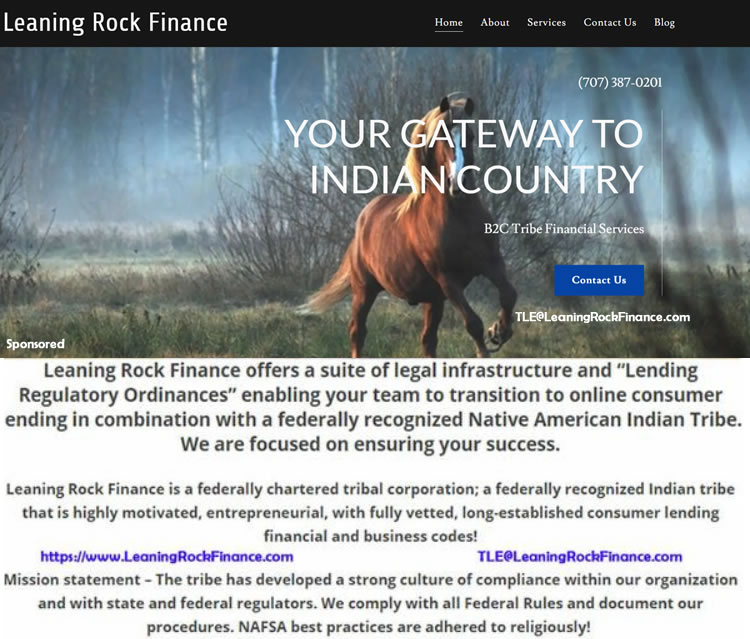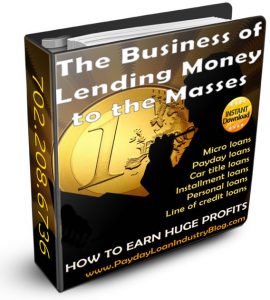Are You Interested in Tribe Collaborations? Could this solve your *California HB539 <36% APR Rate Cap issue?
Wondering if the Economics Make Sense?
Afraid you’ll wind up like Scott Tucker?
*Effective January 1st, 2019, California Lenders operating with a CFL License can only fund loans of $2500+ with 36% APR caps!
Tribal Lender Defeats Class Action Lawsuit in the Eastern District of Virginia. Huge Win for Sovereign Immunity!!

The ability of geographically challenged [think casino and natural resource revenue, not an option] federally recognized Native American Indian tribes to participate in E-commerce collaborations with Silicon Valley, servicer/marketers, investors, and other sophisticated experienced entrepreneurs HAS IMPROVED DRAMATICALLY since the days the Scott Tucker’s of the world participated in the “business of lending to the masses.”
In today’s environment, a tribal E-commerce business model that benefits ALL parties is easily accomplished. All the pieces are in place. Compliance, regulatory oversight, realistic revenue share agreements, tribal lending business entities, consumer-friendly loan products, capital, and experienced 3rd-parties for outsourcing if needed. It’s simply a matter of introductions! That’s what I do.
[For an intro: LeaningRockFinance.com] or email: TLE@LeaningRockFinance.com
My readers are fully aware of all the studies and papers produced by our industry, the so-called consumer advocates, PEW, the multitude of federal and state agencies, the myriad of church and charitable groups ad nauseam who continue to fret about “predatory lending” and “cycle of debt” issues.
MEANWHILE, the FACT REMAINS: Approximately 140,000,000 plus/minus US residents cannot access $500 cash when faced with a sudden, unexpected, frightening financial emergency! Cars to get to work break down, lights get turned off, contractors need to purchase materials, hours are cut back by employers, gig workers become ill and can’t “gig,” prescriptions have to be filled…
How is it possible when we have record low unemployment, low inflation, 2 income households, 100’s of thousands of jobs go unfilled and still, there are millions of Americans who cannot access $500 cash today? The reasons are varied and the nuances many. BUT, it’s a fact.
The regulators, legislators and 1% cannot quench the demand for quick, no-hassle $small-dollar loans by the masses!
So what to do? Allow capital to partner with entrepreneurs to embrace technology in all it’s forms, unfettered by pre-internet infrastructure, bureaucracy, and rules that simply no longer reflect the realities of today.
Rather than “big-brother” and incumbents dictate the rules of the game, enable collaborations between creative minds to build and partner disparate expertise in finance and tech and capital to create and deliver small-dollar loans that truly result in win-win scenarios for all parties to solving this challenge!
Again, for a formal, DISCREET introduction & exploration to a collaboration: Click LeaningRockFinance.com
Big Picture Loans Defeats Class Action Lawsuit in Eastern District of Virginia
Consumer loans offered by the U.S. federally recognized Native American Indian tribes are legal and sovereign per the U.S. 4th District of Virginia.
When creative groups of enrolled tribal members, capital and experienced 3rd party collaborators join forces resulting in definitive financial benefits for all parties, the Fourth Circuit Court ruled sovereign nation status is in order.
A class-action lawsuit, brought against Big Picture Loans, was recently overturned by the Fourth Circuit.
Big Picture Loans is a tribal lender offering payday, installment and line-of-credit loans to consumers via their online platform. Big Picture is owned and operated by the Lac Vieux Desert Band of Lake Superior Chippewa Indians, a federally recognized Indian tribe.
The tribe is a balance sheet lender and secures capital from its servicer/marketers, family offices, and investors from around the country.
In 2017, consumer plaintiffs argued that federal and state laws applied to Big Picture Loans, regardless of their sovereign immunity. The tribal lender, however, argued that they are entitled to sovereign immunity, regardless of state or federal laws.
Initially, the U.S. District Court rejected Big Picture Loans assertions that they are immune from the suit.
However, an unexpected turn came about when the U.S. District Court decision was reversed by the Fourth Circuit.
Reason: The U.S. District Court was found to be erroneous in their decision in claims that Big Picture Loans is not an arm of the Tribe.
The case was officially dismissed, giving the lender and it’s technology partners, in this case, Ascension, another victory for tribal lenders.
Further, the Fourth Circuit concluded that, regarding tribal lenders, it will adopt the Ninth Circuit’s first five breakthrough factors when determining tribal sovereign immunity in future cases.
The Future for Tribal Lenders
Tribal Lenders and their 3rd party servicer/marketers should adhere to the following five breakthrough factors by the Ninth Circuit if they wish to prevent lawsuits in the future.
1) Method of Creation According to the court’s findings, business formation under Tribal law weighs in favor of sovereign immunity. Organized under the Tribe’s Business Entity Ordinance via Tribal Council resolutions, Big Picture Loans and Ascension, were in fact, exercising powers delegated to it by the Tribe’s Constitution.
2) Purpose Tribal nations receive little, if any, federal or state assistance. Big Picture Loans argued the case that the goals of their lending program were to support economic development for their tribal nation, which financially benefits the tribe to grow and prosper. As the case stated, the lender proved the business revenue had been used to fund homeownership opportunities, new health clinics, youth activities, college scholarships and much more. If a tribal lender can prove the business revenue helps fund economic development, the Purpose factor has been met.
3) Structure, Ownership, and Management Since the lender was incorporated under tribal laws, and operates and manages the business, the court found that this weighed in favor of tribal immunity.
4) Intent to Extend Immunity Tribal lenders must not extend immunity to any third-party partners. The court found that BPL indeed did not provide immunity to any of their partners outside of the tribe, specifically Ascension.
5) Financial Relationship A lawsuit could prove to be devastating to a tribal nation if a lender is found guilty. According to the court, this would severely impact the Tribal Treasury in a way that would limit economic growth. Therefore, the fifth factor was in favor of BPL.
Based on these five factors, the Fourth Circuit ruled that all factors were being upheld by Big Picture Loans and Ascension.
Are you interested in collaborating with tribal lenders? Leaning Rock Finance is interested in exploring collaborations in an effort to continue to deliver eCommerce platforms and capital to geographically challenged tribes lacking income-producing casinos, natural resources… Visit Leaning Rock Finance for an introduction or simply email: TLE@LeaningRockFinance.com

Jer- Trihouse 702-208-6736 Cell
Knowledge Store: Resources for Lending $$ to Consumer
TrihouseConsulting@gmail.com






